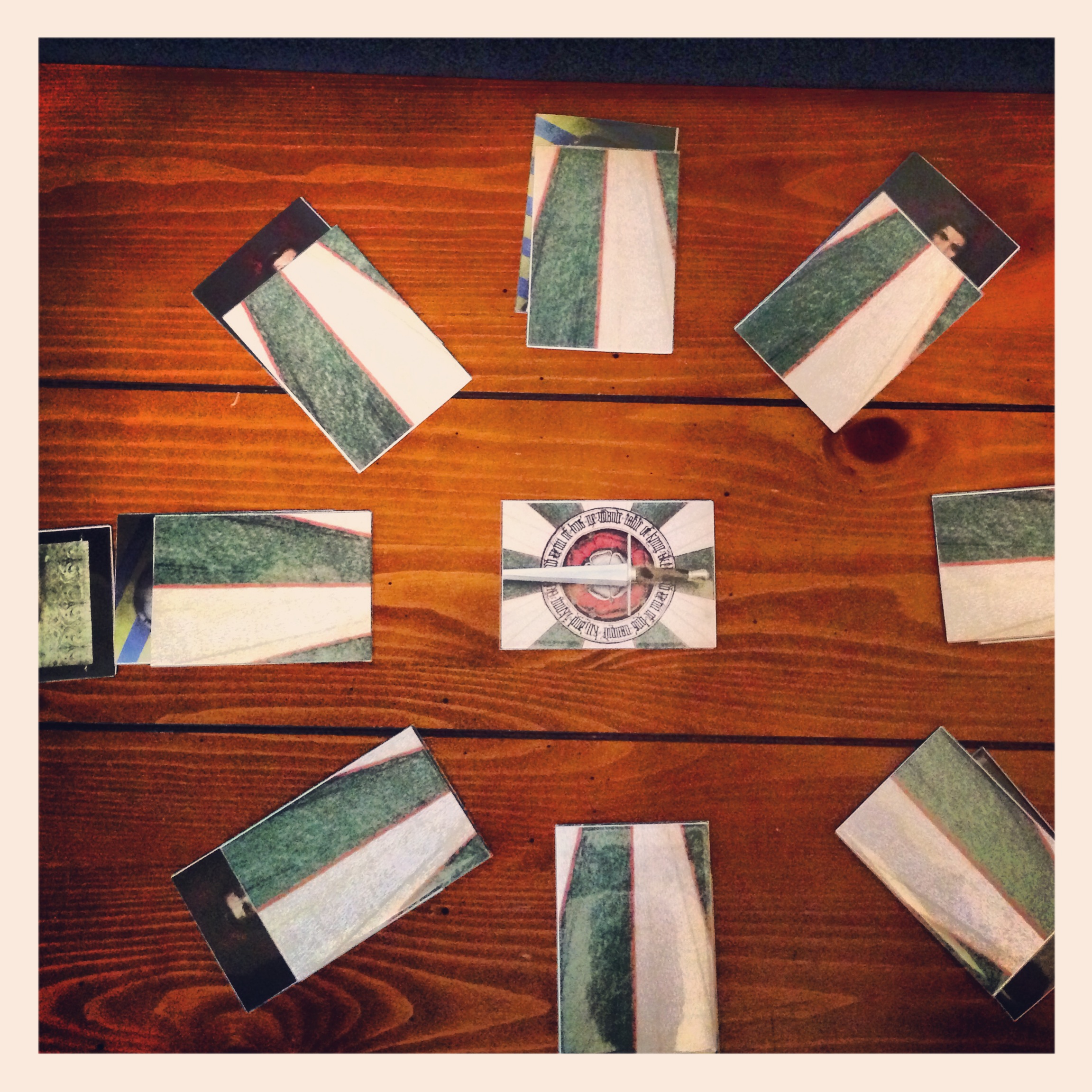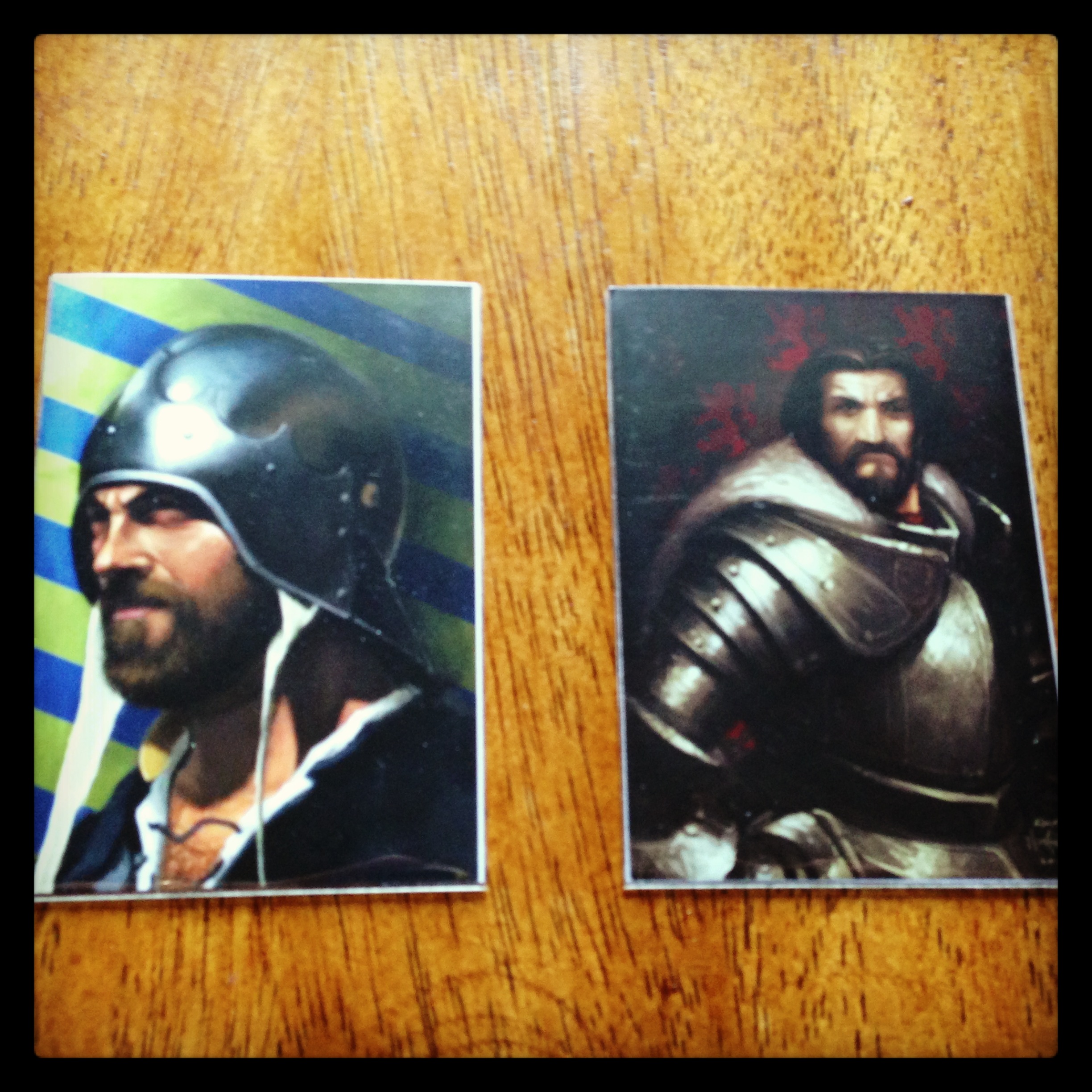Guile—A Double-Take (P)Review
 Is 2013 the year of the tiny card game? I dunno, but we've already seen some corkers in the form of Coup and Hanabi. The guys at Terra Nova Games sent us a preview copy of their new Kickstarter project Guile, and we're here to give you our impressions. Please note: The copies we reviewed were preproduction prototypes. Artwork, rules, and...well, everything might change before the final game is released. This review is based on what we received, with the understanding that tweaks (minor or major) may happen.
Is 2013 the year of the tiny card game? I dunno, but we've already seen some corkers in the form of Coup and Hanabi. The guys at Terra Nova Games sent us a preview copy of their new Kickstarter project Guile, and we're here to give you our impressions. Please note: The copies we reviewed were preproduction prototypes. Artwork, rules, and...well, everything might change before the final game is released. This review is based on what we received, with the understanding that tweaks (minor or major) may happen.
Components
8 Knight cards—four of Arthur and four of Mordred
10 Influence cards—three 1's, three 2's, two 3's, and two 4's
1 Cycle card
1 Turn card
3 Victory cards
Setup
 Decide which player will play Arthur, and which will play Mordred; there's no gameplay difference between the two of them. Just know that if you're the Mordred player, deep down you're a rotten, thieving, low-down scoundrel. Place the Knight cards in a circle on a table—alternating between the two players' Knights. This will create a Round Table—see what they did there?!
Decide which player will play Arthur, and which will play Mordred; there's no gameplay difference between the two of them. Just know that if you're the Mordred player, deep down you're a rotten, thieving, low-down scoundrel. Place the Knight cards in a circle on a table—alternating between the two players' Knights. This will create a Round Table—see what they did there?!
Place the Turn card above one of the Knights on the outside of the circle; then place the Cycle card sword-side-up below that same Knight card on the inside of the circle.
Next, shuffled the Influence cards, deal four to each player, and set aside the remaining two unseen. Each person looks at his or her Influence cards, and players simultaneously place one Influence card onto each of their Knight cards, so that there a bit of the Knight card peeking out from under the Influence card.
Gameplay
You'll play at least two, but no more than three, rounds, and each round will consist of eight turns for each player. The player whose Knight is above the Cycle card (in the game, this Knight is called the Knight-Errant) begins. On your turn you can do one of two things:
Look at the Influence card currently on top of the Knight-Errant, and then place it back.
Swap the Influence card currently on top of the Knight-Errant with any other card—without looking at either one.
Then just move the Cycle card one Knight clockwise, and it's now the other player's turn. When the Cycle card gets back around to the Knight under the Turn card, the game is halfway over, and you flip the Cycle card from the sword-only side to the side that shows the sword and some gold. This signifies you're in the second half of this short round.
You continue alternating turns until the Cycle card gets back to the Turn card again, and the round is over. Flip over the Influence cards currently on your Knights and count up Influence. The person with the most wins one of the three Victory cards, and the first person to win three Victory cards wins the game.
One of the 4 cards—and one of the 3 cards—has a dagger stuck into the number. If there's a tie on Influence, the player with the highest card with a dagger in it wins the tie. (The 3 card has a dagger just in case both 4's happen to be the two cards that are out this round.)
If no one has won, you move the Turn card one Knight clockwise and do it all over again—including dealing out all-new Influence cards to each player—but the other player will start this round.
That's it!
Recommendations
Youth Group Game? Not really! The biggest barrier for this is that it only plays two players. But if you're meeting a student for a soda, and looking for a quick game to play, go for it!
Party Game? Not really! Again, only two players, so unless you're at a party where everyone but you and a friend is playing Apples To Apples for the 1,000th time, this won't really work.
Family Game? Sure! Not the whole family, but we each played this with our oldest sons (7 and 8), and they both liked it.
Gamers' Game? Depends! My group didn't care for it much, but your group might.
The Verdict
 Firestone—I'll start with some aesthetic things: I really think the back of the Influence cards should be uniform. It's not that each card back is different, but if you look at the image above, the whole thing tapers toward one end of the card, and the colors alternate. I'm not sure if they're asymmetrical so that people can create some sort of private orientation scheme to keep track of which card is which, but it just seems that on games with trackable information it's almost always better to have the card backs look the same—there's a reason standard card decks have uniform backs.. (Again, these are prototype cards, so that might change before it's final. I hope so!) It's also weird that the darker-colored Knight is the Good Guy, and the bright one is the Bad Guy. But that's not a complaint—it's just odd and surprising.
Firestone—I'll start with some aesthetic things: I really think the back of the Influence cards should be uniform. It's not that each card back is different, but if you look at the image above, the whole thing tapers toward one end of the card, and the colors alternate. I'm not sure if they're asymmetrical so that people can create some sort of private orientation scheme to keep track of which card is which, but it just seems that on games with trackable information it's almost always better to have the card backs look the same—there's a reason standard card decks have uniform backs.. (Again, these are prototype cards, so that might change before it's final. I hope so!) It's also weird that the darker-colored Knight is the Good Guy, and the bright one is the Bad Guy. But that's not a complaint—it's just odd and surprising.
Jeremiah— The asymmetrical backs didn't bother me so much; I mean, what's to stop your opponent from spinning them and blowing up your foolproof plan anyway? I was a little confused as to the color scheme of the knight cards, These aren't things that "break" the game—as Firestone said, they are aesthetics, and prototype aesthetics at that.
Firestone—I played this with a few gamers, and their reaction was mostly neutral. It's not that they didn't understand it, or want to give it a chance...they just felt there wasn't much there there. I had much better luck getting my 8-year-old to play. He enjoyed it quite a bit—especially after we talked about some things to do to move it beyond just playing Guile as a memory game. Once he started bluffing (which he's hilariously terrible at), he liked it even more. He was able to hold his own, too, because his chaotic, unconventional, 8-year-old gameplay completely threw me off and made it really hard for me to keep track of where my good (and bad) cards were. So often the VP reveal was an utter surprise...
I'm not saying this would only work with kids, or that your game group wouldn't enjoy it. This was just my experience.
Jeremiah— Truthfully I haven't played a ton of these 2-player mini-games; to me it seems that designing a game of this type would be a more difficult task than say a larger board or card game. Everything is so incredibly streamlined that the slightest tweak can destroy the core of the game. That being said, the two actions a player can take are a very precarious balance. The "look at the card on your current knight" action seems to be only useful for about half of a round. If you can remember your first one or two cards, there's no need to look at them. But if you put a lower card on the first one or two and switch them right away, by the time you get a chance to look at the card you switched for, it doesn't matter anyway because you can't do much about it (only switch it with the card on your next knight). I kept hoping for a 3rd turn in a round to make the game go more like this: strike, gather information, then counter-strike. It may just be the "big game" gamer in me...
Firestone—Yeah, the thing I kept thinking in this game is that there's not really time to act on the information you're given. In the early game you know what's out there, so if you have a low card, you'll probably swap it, assuming the one you swap for is more valuable. But if you know the card on turn is a 4...what do you do with it? Bluff with it? Swap it with another of yours? Just feign ignorance and look at it? The early game was full of turns where I didn't want to do anything, and later turns moved too quickly to act. I completely agree with Jeremiah—it seems that adding a third round of play would give me a chance to do something with the info I glean. Maybe that would wreck my ability to track cards, though...I dunno.
Jeremiah— I love that this is a game that is super easy to learn, and teach, because it is so streamlined. This style of game is going to do a lot for the industry in capturing the casual gamer. In the case of Guile the downside is if memory based games aren't your thing, there's not much else to grab onto here. The upside is if you like games with a memory based core mechanic, you're going to LOVE this game!
Firestone Final Verdict—I've enjoyed playing this with my son; I wish I enjoyed playing this with my game group. We love small filler card games, but this one just fell flat for us. It's more than just a memory game, but the meta game aspect isn't given enough time to percolate...
Jeremiah Final Verdict— I'm very happy that games like this are becoming popular. I love simple mechanics, and quick-playing games that cause a lot of tension for the short amount of time you're playing, and Guile certainly delivers that! I'm really rooting for this game; I feel with a few small tweaks the game can move from good to great!
There's only a week left in the Kickstarter campaign, and the game has funded! So you can get in on the fun for only $15—or $20 to get the game and some extras, such as variant cards. (We didn't play with these variants, but they look interesting. The Guinevere one, for instance, changes things if she's on Lancelot at game end. I think cards such as this one could really make the game more interesting. Again, it would be nice to have another round to maneuver her...)
Thanks so much for reading, and joining us in this 1-Year Blogiversary week! Don't forget: We're giving away some cool stuff—including a copy of The Great Heartland Hauling Company tomorrow—and all you've got to do to enter is subscribe via email, over on the right.-------->
We're also on Twitter, Facebook, Instragram, and YouTube! (Whew!)